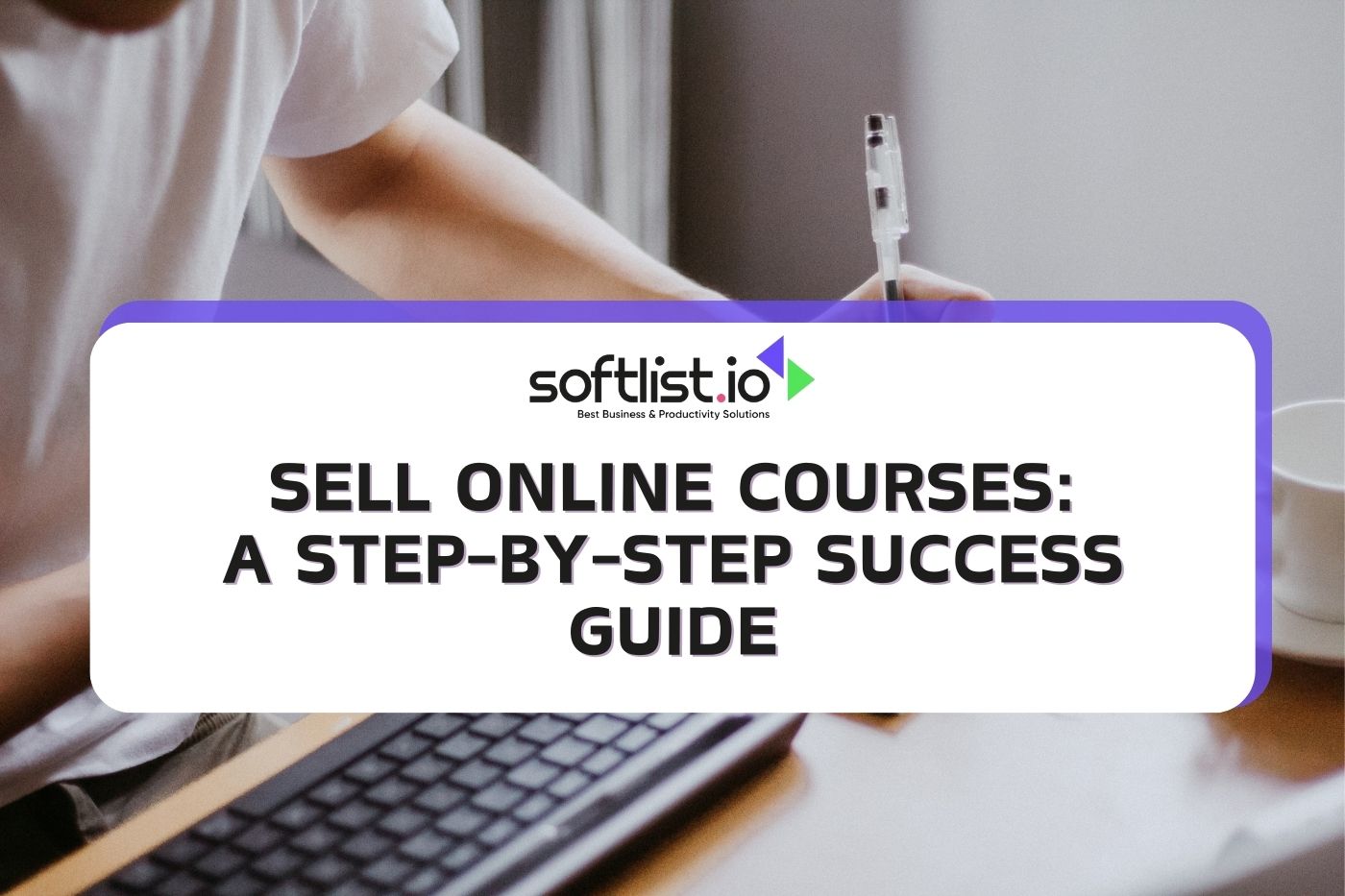Ready to cash in on your smarts with an online course this year? With more people hungry for e-learning than ever, it’s a prime time for experts like you to get in on the action. Selling an online course isn’t just a fancy move—it’s a smart play that can pay off.
The e-learning market is on fire; getting the know-how to work it can make you stand out. This article is your handy map to banking more bucks from your online courses.
We’ll walk you through understanding market trends, crafting content that keeps learners hooked, pricing your course right to attract keen students, and picking a platform that puts your course in the spotlight.
So, if you’re a pro at teaching or just pumped to share your skills online, this guide’s got the golden tips to help turn your wisdom into cold, hard cash. Let’s get to it!
Comprehending The Market for Online Courses
Source: Canva
Building online courses is a great way for experts to share their knowledge with people worldwide in the fast-paced world of digital education. One of the most important ways to sell online courses is to start them through course marketplaces.
Teachers must keep up with the latest trends and technologies as online learning grows because of more course options and students’ preferences for learning from home.
By creating an online course, teachers can use these platforms to reach many students, have a big effect on digital education, and start a cycle of growth and new ideas.
- Current Trends in Digital Education: This evolution highlights the increasing necessity for educators and content creators to adeptly create and sell courses online, ensuring their offerings are not only accessible but also aligned with the latest educational trends.
- Learner Demographics: This diversity underscores the importance of leveraging an online courses platform that caters to a broad spectrum of learning preferences, enabling creators to effectively create a course that meets the varied needs of today’s learners.
- Course Demand Analysis: It’s not just about identifying trends; it’s about comprehensively analyzing how to position your course to meet these evolving needs. This involves a strategic approach to course creation, ensuring that your offerings are relevant and desirable to your target audience.
- Technology and Platform Evolution: As digital education grows, selecting the right online learning platform becomes pivotal. This choice impacts how effectively you can sell courses online and how well you can engage with your students, enhancing their learning experience.
Preparing Your Course Content
Source: Canva
Crafting content for your online course is a pivotal step toward the success of your online school. This task is about more than compiling information. It’s about utilizing insights that help you create an engaging, insightful, and valuable learning journey for your students.
Effective content preparation is essential for anyone aiming to create and sell an online course, demanding a strategic approach to curriculum development, content delivery, and boosting learner engagement.
Whether you’re designing a specific course or looking to create your online course from scratch, remember that the quality of your content directly influences the educational experience you offer.
- Curriculum Development: Start with a robust curriculum that outlines your course objectives, key takeaways, and learning outcomes. Ensure it’s structured in a way that gradually builds upon knowledge, making complex concepts easier to understand.
- Content Delivery: Choose the most effective formats for delivering your content, considering the diverse learning styles of your audience. Mixing traditional lectures with interactive elements can enhance engagement and retention.
- Engagement and Interaction: Keeping your audience engaged throughout the course is crucial. Interactive elements and community-building activities can significantly boost learner participation and satisfaction.
- Visual and Audio Quality: High-quality visuals and clear audio are essential for keeping students engaged and ensuring they can easily absorb the material.
Setting the Right Price for Your Course
For those who are making and selling online courses, setting prices means fully understanding what makes your course special and how it differs from other options in the online business world.
By giving these things careful thought, you can make your course a profitable part of your online business and set it up for success. Remember that the goal is to make and sell online courses that teach and give real value to the people who buy them. This way, the work you put into making the course will be well worth it.
- Understand Your Course’s Unique Selling Proposition (USP): Identify what makes your course different and better than others. Is it the depth of knowledge, unique teaching methods, or perhaps exclusive resources?
- Consider Production Costs: Factor in the costs of creating and hosting your online courses, including any investments in technology or marketing.
- Research Audience’s Paying Capacity: Gauge the financial willingness of your target audience. Understanding the demographic’s average budget for continuous education can guide your pricing strategy.
- Evaluate the Course’s Outcomes for Students: The more transformative and valuable the outcome, the higher the price point you can justify.
How to Determine Your Online Course’s Value
Finding out what your online course is really worth is important for setting a fair price that keeps you competitive in the market. This evaluation should look at some things, such as the quality of the content, the level of expertise provided, and the demand for the subject taught.
- Content Uniqueness and Quality: High-quality, unique content that cannot be found elsewhere adds significant value to your course.
- Expertise and Credentials: Your background, experience, and qualifications in the course subject matter can increase its perceived value.
- Market Demand: The higher the demand for the knowledge or skills you teach, the more valuable your course holds.
- Student Success Stories: Testimonials and case studies showcasing past students’ success can greatly enhance your course’s perceived value.
Competitive Pricing Analysis
A competitive pricing analysis involves examining what similar courses are charging and understanding your position within the market. This analysis is critical to ensuring your course is priced competitively, offering your students value while maintaining your profit margins.
- Identify Direct Competitors: Look for online courses that offer similar content and outcomes. Note their pricing structures.
- Analyze Price Range: Determine your niche’s high, low, and average prices to understand where your course fits.
- Value Proposition Comparison: Compare your course’s features, benefits, and unique selling points against competitors to justify the pricing.
- Adjust for Market Position: If your course offers more value or is aimed at a more premium segment, pricing above the average may be justified.
Selecting the Optimal Platform for Hosting and Marketing Your Course
Selecting the best online course platform for your digital offering is a pivotal decision that can significantly impact its success. The ideal platform serves as a host for your content and as a partner in the best way to sell online, playing a crucial role in marketing, sales, and enhancing the user experience.
This section will guide you through the essential considerations to ensure you choose a platform that aligns with your course objectives and audience needs, optimizing your online business strategy.
- Platform Usability: Ease of use for both the course creator and participants. Look for intuitive design, straightforward course creation tools, and seamless user navigation.
- Technical Features: Essential technical capabilities that enhance the learning experience and course management.
- Marketing and Sales Tools: Features that support your course promotion and sales strategy.
- Support and Community: The platform’s level of support and the presence of an active user community.
- Pricing and Commission: Understand the platform’s cost and how it affects your course pricing strategy.
Marketing Your Online Course
Marketing your online courses effectively is crucial for attracting and retaining students. In the digital age, where information overload is common, standing out and reaching your target audience requires strategic planning and execution.
This section explores leveraging various digital marketing channels to increase your course’s visibility and appeal.
Key Strategies:
- Identify Your Target Audience: Understanding the demographics, interests, and online behavior of your potential students.
- Content Marketing: Create valuable and relevant content that addresses your audience’s needs and interests, positioning your course as a solution.
- Social Media Engagement: Utilize platforms like LinkedIn, X, and Facebook to connect with your audience, share insights, and promote your course.
- Email Marketing Campaigns: Develop personalized email marketing strategies to nurture leads and convert them into students.
Engaging Your Target Audience
Engagement is the key to building lasting relationships with your students and ensuring the success of your online courses. You can significantly boost interest and enrollment in your courses by employing targeted strategies to engage your audience.
Engagement Techniques:
- Interactive Content: Incorporate quizzes, surveys, and videos to make learning more engaging.
- Community Building: Create forums or social media groups to foster a sense of community among students.
- Feedback Loops: Regularly solicit feedback from your students to improve your course content and delivery.
- Live Sessions: Offer live webinars or Q&A sessions to interact directly with students and address their queries.
Strategies for Educators to Utilize Digital Marketing
Digital marketing gives teachers who want to make money teaching online courses great tools to make their courses more visible and get more students to sign up. You can effectively reach more people and meet your course sales goals if you strategically target your marketing to the online education sector.
It’s important to know how to position and promote your offerings, whether you want to start a full-fledged paid program or a free course to build your audience.
Using digital marketing strategies in your online courses will not only help them make more money, but they will also make sure they meet the needs of students worldwide, which will help your educational content reach its full potential.
Tactics to Explore:
- SEO (Search Engine Optimization): Optimize your course landing page and content for search engines to improve visibility.
- PPC (Pay-Per-Click) Advertising: Use targeted ads on search engines and social media to drive traffic to your course.
- Content Marketing: Develop educational blog posts, infographics, and videos that highlight the value of your course.
- Social Media Marketing: Engage with potential students on platforms where they spend their time online.
Optimizing Your Sales Funnel
The sales funnel is a crucial component of selling online courses, guiding potential students from awareness to purchase. Optimizing each stage of the funnel ensures a smooth transition for prospects, increasing the likelihood of conversion.
Steps for Optimization:
- Awareness: Use SEO, content marketing, and social media to raise awareness of your course.
- Interest: Engage interested users with detailed course descriptions, previews, and testimonials.
- Decision: Offer trials, demos, or limited-time discounts to encourage prospects to purchase.
- Action: Simplify the enrollment process, making it as straightforward as possible for students to sign up.
Key Takeaway
To sell online courses, you need to make content that people want to read, know, and target your audience, use digital marketing, and make sure your sales funnel works as well as it can to get the most sales possible.
Each step is important for the success of your online courses: knowing the market for online courses, getting your target audience interested, marketing your course well, and making the sales journey as smooth as possible. These tips, like making a good online course and setting a fair price for it.
Online education will keep changing, giving people who make courses new chances and problems to solve. To succeed in this space, you must use course marketplaces and build your online presence.
Online education continues to evolve, presenting new opportunities and challenges for course creators. Exploring course marketplaces and discovering one of the best ways to build an online presence will be crucial for those looking to thrive in this space.
We encourage educators and experts to share their experiences and insights on selling online courses, fostering a community of continuous learning and improvement.
FAQs – About Selling Online Courses
How do I protect the intellectual property of my online courses?
Protect your course’s intellectual property using copyright laws and digital rights management. Register your materials to keep them safe from unauthorized use.
Can I sell my online courses internationally?
Yes, you can sell your course to a worldwide audience by considering different languages, cultures, and payment methods. Adapting your content and marketing can boost your course’s international appeal.
What are the common pitfalls in online course creation and how to avoid them?
Common issues with creating online courses include not researching the market well, vague course structures, and low student interaction. Avoid these by knowing your audience, setting clear goals, and making your course interactive.
How do you measure the success of your online course sales?
To see if your online course is hitting the mark, check how many sign-ups and completions you get, what students say, and how much you earn. Analytics tools can help you understand and improve your course’s impact.
What are the tax implications of selling an online course?
You may have to deal with income and sales tax when selling online courses. It’s best to get advice from a tax expert to stay on top of the laws in your region.
Unlock Your Course’s Full Potential with Softlist
Online courses are becoming more popular, so making money from them is more important than ever. Softlist gives business and education professionals all the information and tools they need to make smart choices.
If you follow our expert advice, you’ll make your digital education business better and help our affiliate mission to improve online learning.






